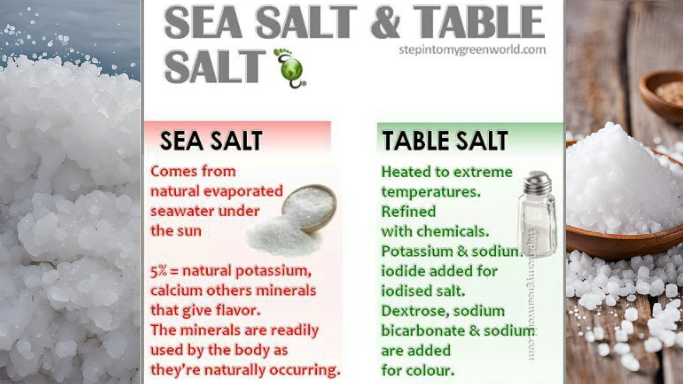Salt is an essential mineral in the human diet, crucial for various bodily functions, such as regulating fluid balance and aiding nerve transmission. However, not all salts are created equal. Sea salt and table salt are two popular varieties, each with distinct characteristics. While both contain sodium chloride, there are key differences in their production, mineral content, and potential health implications.
Production and Processing
The primary difference between sea salt and table salt is how they are produced. Sea salt is harvested by evaporating seawater, typically through solar evaporation or by using mechanical processes to speed up evaporation. This results in large, coarse crystals, and because it is minimally processed, sea salt often retains trace minerals such as magnesium, calcium, and potassium. These minerals can give sea salt a slightly different taste and color, depending on its source.
In contrast, table salt is usually mined from underground salt deposits, refined, and processed to remove impurities. During this refining process, many of the naturally occurring minerals found in sea salt are stripped away, leaving behind pure sodium chloride. As a result, table salt tends to have a more uniform, fine texture and a more neutral taste.
Mineral Content
One of the main reasons some people consider sea salt to be "healthier" than table salt is its mineral content. Sea salt can contain trace amounts of minerals, such as magnesium, iron, and calcium, which are naturally present in seawater. These minerals, though present in small amounts, can contribute to a more complex flavor profile. However, the amounts of these minerals are usually so small that their impact on health is minimal.
On the other hand, table salt has little to no trace minerals due to the refining process. However, table salt often has iodine added to it, an important nutrient that supports thyroid function. Iodine deficiency can lead to thyroid problems, so the fortification of table salt with iodine has been a key public health initiative, particularly in regions where iodine-rich foods are scarce.
Sodium Content
Both sea salt and table salt are primarily composed of sodium chloride, and they contain similar amounts of sodium by weight. In fact, a teaspoon of table salt typically contains about 2,300 milligrams of sodium, the recommended daily limit for healthy adults. Sea salt may contain slightly less sodium per teaspoon due to its larger crystals, but this difference is minimal, and people should still use it in moderation.
Excessive sodium intake is linked to high blood pressure, which can increase the risk of heart disease and stroke. Therefore, whether you prefer sea salt or table salt, it is essential to monitor your overall salt consumption to avoid exceeding recommended limits.
Health Considerations
While both salts can be part of a healthy diet when used in moderation, there are some health considerations to keep in mind.
-
Iodine Deficiency: The most notable health benefit of table salt over sea salt is its iodine content. Iodine is an essential nutrient for thyroid health, and iodine deficiency can lead to goiter, developmental delays in children, and other health problems. Because iodine is not naturally found in sea salt, those who do not get enough iodine from other dietary sources (like seafood, dairy, and eggs) may want to opt for iodized table salt.
-
Trace Minerals in Sea Salt: While sea salt does contain trace minerals like magnesium and calcium, the amounts are so small that they are unlikely to have any significant health benefits. The minerals in sea salt may also vary depending on the location where it was harvested, so one batch of sea salt may contain different minerals than another.
-
Additives in Table Salt: Table salt often contains anti-caking agents to prevent it from clumping together. While these additives are generally considered safe for consumption, some people may prefer the purity of sea salt, which typically does not contain these additives.
Flavor and Culinary Uses
When it comes to cooking, the choice between sea salt and table salt may also come down to personal preference. Sea salt is often praised for its more complex flavor, which is attributed to the minerals it contains. It is typically used as a finishing salt, sprinkled over dishes just before serving, where its crunch and flavor can shine. Sea salt's coarser texture makes it ideal for certain culinary applications like seasoning meats or garnishing salads.
Table salt, on the other hand, has a finer texture and dissolves more quickly, making it ideal for baking and general cooking where precise measurements are necessary. It is also less expensive and more readily available in most kitchens.
Which Salt Should You Choose?
Ultimately, whether sea salt or table salt is "better" for you depends on your specific dietary needs, preferences, and health considerations.
Choose Sea Salt if you prefer a more natural, less processed product with a complex flavor. Sea salt can be a good option if you enjoy the crunch of larger crystals and want to use it as a finishing touch to your dishes.
Choose Iodized Table Salt if you are concerned about iodine deficiency or if you require a more uniform texture for baking and cooking. Iodized salt is particularly important for populations with limited access to iodine-rich foods.
In either case, it’s important to use salt in moderation, as excessive sodium intake can lead to serious health problems like high blood pressure and heart disease.
Conclusion
Sea salt and table salt both have their own advantages and uses, but neither is inherently "better" than the other. Sea salt may offer some additional trace minerals and a more complex flavor, while table salt is a reliable source of iodine and a staple in most kitchens. The key to maintaining good health is moderation—regardless of which type of salt you choose. The best approach is to consume salt in reasonable amounts while considering your individual health needs, including iodine intake, and to balance it with a nutrient-rich diet.




